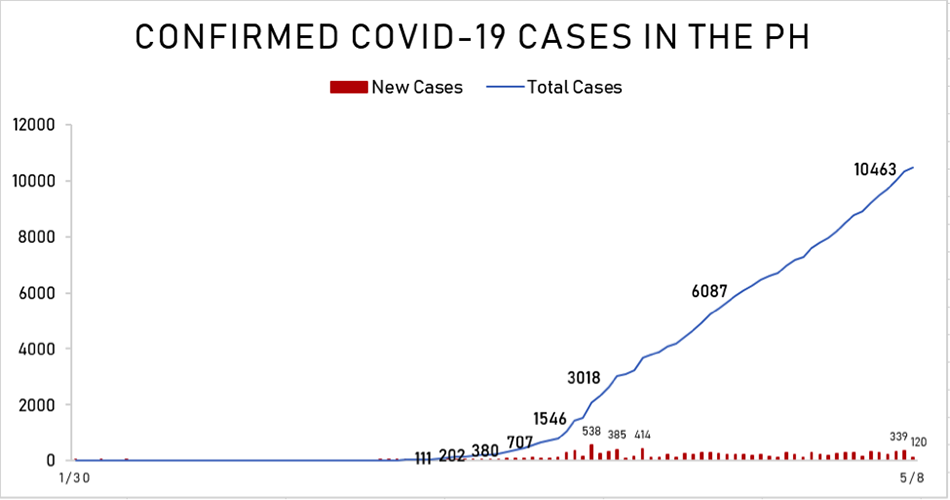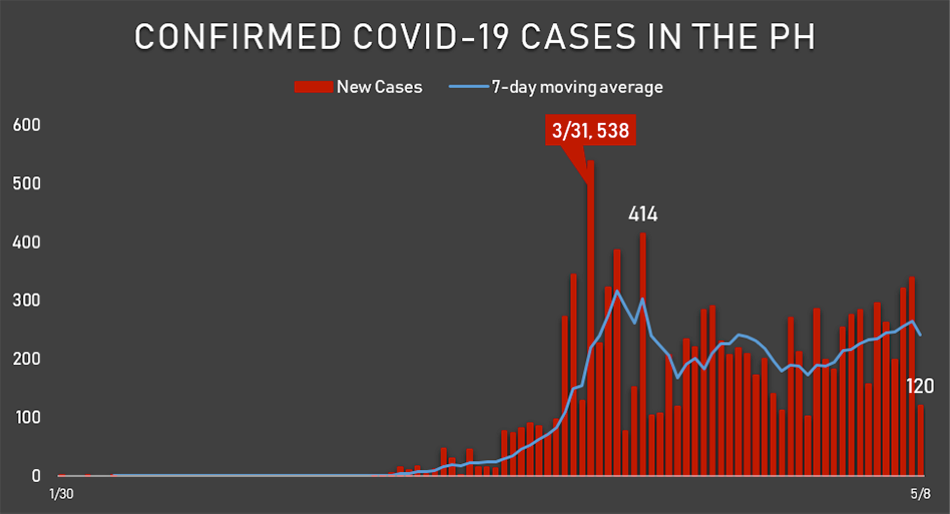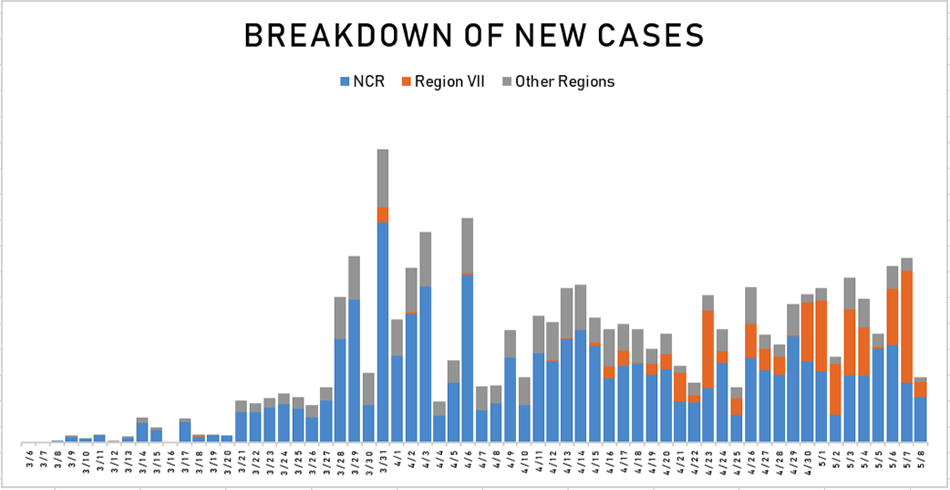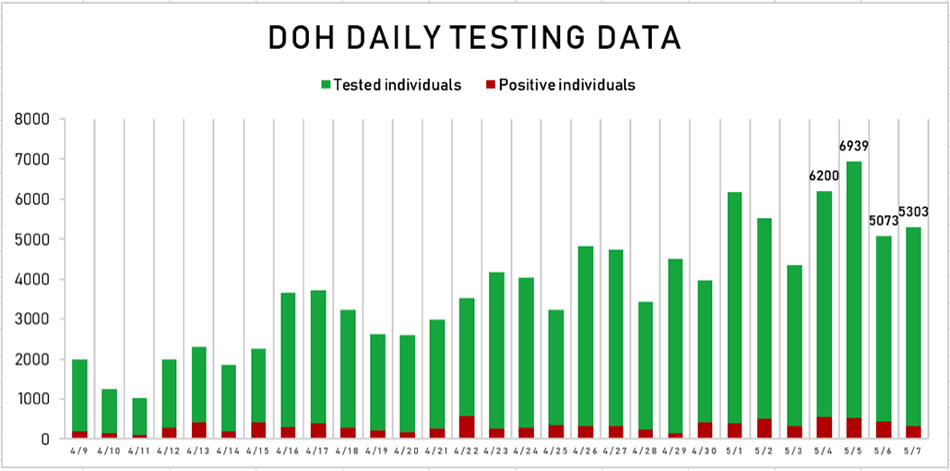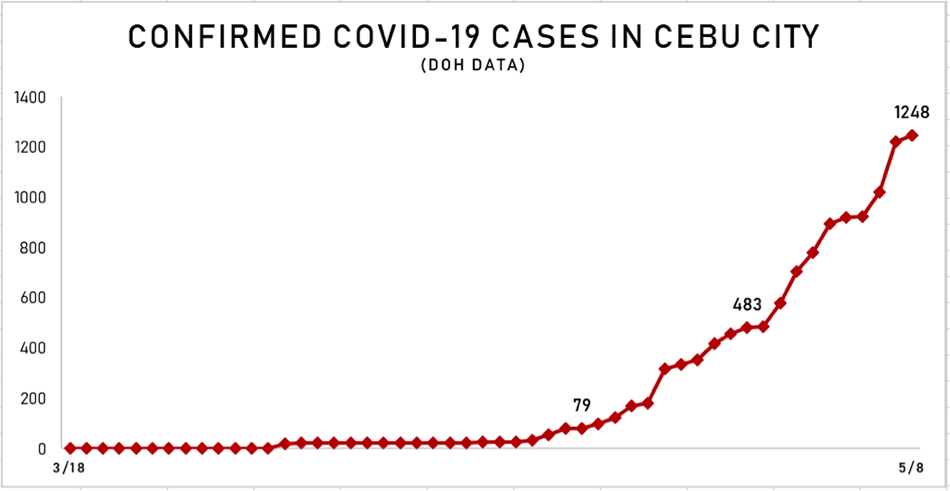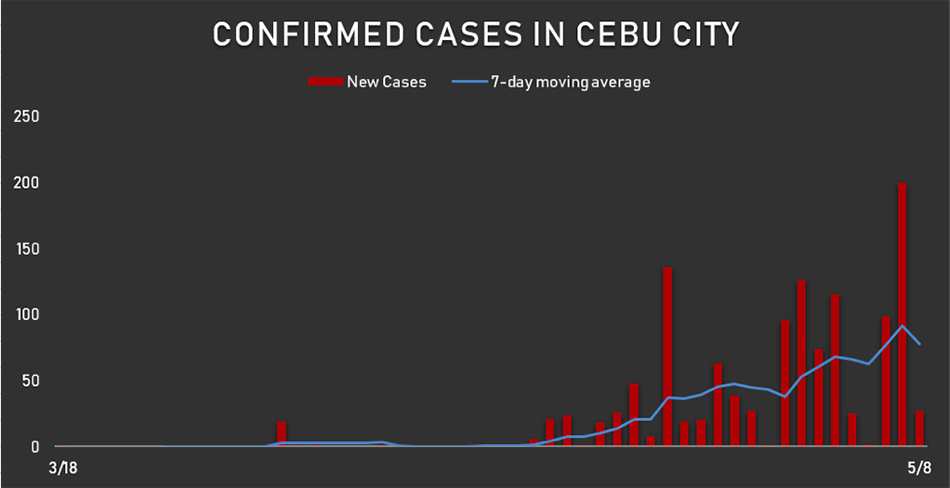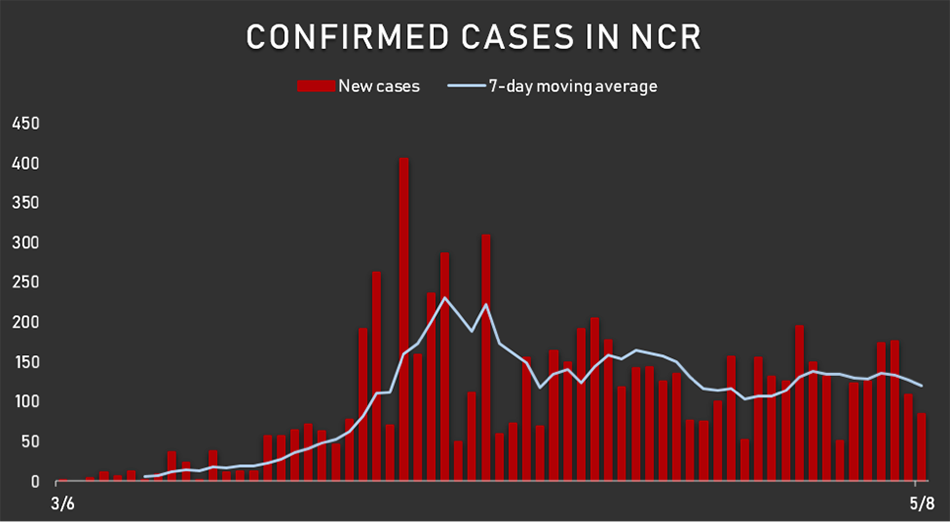100 days into reporting the first COVID-19 case, where is the Philippines now? | ABS-CBN

Welcome, Kapamilya! We use cookies to improve your browsing experience. Continuing to use this site means you agree to our use of cookies. Tell me more!
100 days into reporting the first COVID-19 case, where is the Philippines now?
100 days into reporting the first COVID-19 case, where is the Philippines now?
Edson Guido,
ABS-CBN Data Analytics
Published May 11, 2020 01:05 AM PHT
MANILA - Since the Philippines reported its first positive COVID-19 case on January 30, drastic measures have been put in place by the government to curtail the spread of the deadly virus.
On March 12, President Duterte introduced restrictions on immigration, travel, commerce, and gatherings— days after the first case of domestic transmission—and expanded on March 16. The entire Metro Manila is under enhanced community quarantine (ECQ) until May 15.
MANILA - Since the Philippines reported its first positive COVID-19 case on January 30, drastic measures have been put in place by the government to curtail the spread of the deadly virus.
On March 12, President Duterte introduced restrictions on immigration, travel, commerce, and gatherings— days after the first case of domestic transmission—and expanded on March 16. The entire Metro Manila is under enhanced community quarantine (ECQ) until May 15.
Signs are, however, emerging that the Luzon-wide ECQ imposed is working.
Signs are, however, emerging that the Luzon-wide ECQ imposed is working.
On March 14, the Department of Health (DOH) reported a total of 111 confirmed COVID-19 cases in the country. Cases doubled to 202 on March 18, increased to 380 on March 22, 707 on March 26, and 1,546 on March 30.
On March 14, the Department of Health (DOH) reported a total of 111 confirmed COVID-19 cases in the country. Cases doubled to 202 on March 18, increased to 380 on March 22, 707 on March 26, and 1,546 on March 30.
At that time, the ABS-CBN Data Analytics team estimated the doubling time of cases in the country at four days. By April 3, as expected, the number of infections breached the 3,000-mark.
At that time, the ABS-CBN Data Analytics team estimated the doubling time of cases in the country at four days. By April 3, as expected, the number of infections breached the 3,000-mark.
ADVERTISEMENT
Using the same trend of four days, it was expected that the total number of cases would exceed 6,000 by April 7. However, it took until April 18 before this happened—15 days from April 3 instead of the projected four.
Using the same trend of four days, it was expected that the total number of cases would exceed 6,000 by April 7. However, it took until April 18 before this happened—15 days from April 3 instead of the projected four.
NEW CASES
The highest reported number of new cases was 538 on March 31 and then 414 on April 6. The DOH has not reported more than 350 ever since. Looking at the chart below, the 7-day moving average line (used to smooth out the daily variations) in blue also showed that new cases were lower, indeed, on the downtrend compared to early April.
The highest reported number of new cases was 538 on March 31 and then 414 on April 6. The DOH has not reported more than 350 ever since. Looking at the chart below, the 7-day moving average line (used to smooth out the daily variations) in blue also showed that new cases were lower, indeed, on the downtrend compared to early April.
This is consistent with the ABS-CBN Data Analytics team’s analysis that the impact of the ECQ will be felt after two to three weeks, given that symptoms of COVID-19 appear within two to 14 days after exposure.
This is consistent with the ABS-CBN Data Analytics team’s analysis that the impact of the ECQ will be felt after two to three weeks, given that symptoms of COVID-19 appear within two to 14 days after exposure.
While data show the seeming effectivity of the ECQ, reports from recent weeks show an uptrend. On May 7, there were 339 new cases — the highest reported in a month. Why is this so?
While data show the seeming effectivity of the ECQ, reports from recent weeks show an uptrend. On May 7, there were 339 new cases — the highest reported in a month. Why is this so?
Taking a look at the breakdown of new cases by region, the trend will show that the rise can be attributed to the recent surge observed in Region VII / Central Visayas (in orange) perhaps due to more aggressive testing. Ninety percent (or 1,273) of the 1,421 total cases from the region were reported in the last 18 days (April 21 to May 8) alone.
Taking a look at the breakdown of new cases by region, the trend will show that the rise can be attributed to the recent surge observed in Region VII / Central Visayas (in orange) perhaps due to more aggressive testing. Ninety percent (or 1,273) of the 1,421 total cases from the region were reported in the last 18 days (April 21 to May 8) alone.
(For context, 71 percent of the total cases in the weeks prior came from NCR while only two percent were from Region VII)
(For context, 71 percent of the total cases in the weeks prior came from NCR while only two percent were from Region VII)
In the same 18-day period, a total of 4,004 cases were reported at the national level, 32 percent of which came from Central Visayas. NCR, meanwhile, accounted for 55 percent.
In the same 18-day period, a total of 4,004 cases were reported at the national level, 32 percent of which came from Central Visayas. NCR, meanwhile, accounted for 55 percent.
Further solidifying the point above, data show that the Philippines has yet to exceed its target of 8,000 tests conducted per day by the end of April. As seen in this chart, there is no noticeable surge in the number of positive cases (in red) due to increased testing. In fact, the percentage of tests yielding positive results has declined through time.
Further solidifying the point above, data show that the Philippines has yet to exceed its target of 8,000 tests conducted per day by the end of April. As seen in this chart, there is no noticeable surge in the number of positive cases (in red) due to increased testing. In fact, the percentage of tests yielding positive results has declined through time.
Diving deep into Central Visayas, Cebu City is the hotspot for COVID-19 cases with nearly 88 percent of the total cases in the entire region. This was a rapid surge from just the 79 cases reported twenty days ago and the 483 ten days ago. Latest DOH data show that Cebu City has 1,248 cases, making it the city with the second highest number of reported cases in the country. Outside of Cebu province, there are only 18 cases of COVID-19 in Central Visayas.
Diving deep into Central Visayas, Cebu City is the hotspot for COVID-19 cases with nearly 88 percent of the total cases in the entire region. This was a rapid surge from just the 79 cases reported twenty days ago and the 483 ten days ago. Latest DOH data show that Cebu City has 1,248 cases, making it the city with the second highest number of reported cases in the country. Outside of Cebu province, there are only 18 cases of COVID-19 in Central Visayas.
The moving average line of new cases in Cebu City (in blue) is also on an uptrend. Despite the high number of confirmed cases, the current fatality rate is below 1% (9 out of 1,248).
The moving average line of new cases in Cebu City (in blue) is also on an uptrend. Despite the high number of confirmed cases, the current fatality rate is below 1% (9 out of 1,248).
While the number of confirmed cases in Cebu City is on the rise, the ABS-CBN Data Analytics team observes that the trend of new cases in NCR is now flatter relative to the trend seen at the national level, though not yet on a clear downward trend. On average, 120 new cases are reported per day in Metro Manila during the past week.
While the number of confirmed cases in Cebu City is on the rise, the ABS-CBN Data Analytics team observes that the trend of new cases in NCR is now flatter relative to the trend seen at the national level, though not yet on a clear downward trend. On average, 120 new cases are reported per day in Metro Manila during the past week.
While numbers point to the “flattening of the curve”, Filipinos still must be cautious in coming up with sweeping conclusions for several reasons. First, the DOH data is limited by the management of information—from testing on the ground to laboratories doing the heavy lifting.
While numbers point to the “flattening of the curve”, Filipinos still must be cautious in coming up with sweeping conclusions for several reasons. First, the DOH data is limited by the management of information—from testing on the ground to laboratories doing the heavy lifting.
Second, the DOH needs to ramp up its testing. To date, the DOH data show that roughly only 137,089 total individuals were tested.
Still, 138,000 individuals is just one percent of NCR's Projected 2020 Mid-Year Population of 13.8 million (data from the Philippine Statistics Authority). The only way to get a more accurate picture is for testing to ramp up.
Second, the DOH needs to ramp up its testing. To date, the DOH data show that roughly only 137,089 total individuals were tested.
Still, 138,000 individuals is just one percent of NCR's Projected 2020 Mid-Year Population of 13.8 million (data from the Philippine Statistics Authority). The only way to get a more accurate picture is for testing to ramp up.
The health department admits there are limitations because not all hospitals and health institutions are able to report their testing results in a timely or accurate manner. But it did stress that it cannot wait for the healthcare system to perfect its data collection. Decisions need to be made quickly, based on the best available data.
The health department admits there are limitations because not all hospitals and health institutions are able to report their testing results in a timely or accurate manner. But it did stress that it cannot wait for the healthcare system to perfect its data collection. Decisions need to be made quickly, based on the best available data.
So even if government officials are saying there is “flattening of the curve” based on data available, the ABS-CBN Data Analytics team remains prudent in categorically declaring such. Yet, regardless of the lack of consistency, completeness, and accuracy of the information available, this data is what the government has right now, and quite frankly, the only data our decision makers have to work with.
So even if government officials are saying there is “flattening of the curve” based on data available, the ABS-CBN Data Analytics team remains prudent in categorically declaring such. Yet, regardless of the lack of consistency, completeness, and accuracy of the information available, this data is what the government has right now, and quite frankly, the only data our decision makers have to work with.
Source of raw data: Department of Health (data as of May 8)
Source of raw data: Department of Health (data as of May 8)
ADVERTISEMENT
ADVERTISEMENT


